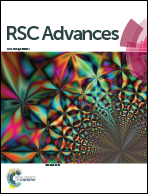Edge functionalization and doping effects on the stability, electronic and magnetic properties of silicene nanoribbons†
Abstract
Through density functional theory calculations the impact of edge functionalization on the structural stabilities, electronic and magnetic properties of silicene nanoribbons (SiNRs) are investigated. –H, –F, –Cl, –Br, and –I edge functionalization of armchair, zigzag, Klein, reconstructed Klein, reconstructed pentagon–heptagon edge types, and their combinations are examined. It is found for the first time that trifluorinated Klein edge SiNR is the most stable edge structure among all edge structures of SiNRs. Furthermore, the stability of trihydrogenated Klein edge SiNR, which is periodically replaced by a dihydrogenated zigzag edge, approaches that of dihydrogenated armchair edge SiNR as the most stable hydrogenated SiNR. It is revealed that asymmetry in edge functionalization or combining different edge types can transform symmetric edge functionalized zigzag SiNRs from antiferromagnetic semiconductors to various magnetic states, such as bipolar spin gapless semiconductors (SGS), ferromagnetic metals and semiconductors, and antiferromagnetic metals. Furthermore, the effects of N or B doping on the stability, electronic and magnetic properties of hydrogenated and fluorinated SiNRs are studied. It is discovered that the mono-fluorinated armchair SiNR shows SGS behavior with 100% spin polarized currents around the Fermi level, when the Si edge atom is substituted by an N or B atom. The remarkable SGS and half-metal characters, and ferromagnetic metals are also observed in N- or B-doped asymmetric edge functionalized zigzag SiNRs, fully functionalized Klein edge SiNRs, and combinations of zigzag SiNRs with reconstructed Klein edge SiNRs. These results encourage further experimental investigations in the development of SiNR-based nanoelectronics with spin tuning.


 Please wait while we load your content...
Please wait while we load your content...